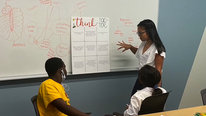- Danielle Dani
- https://www.ohio.edu/education/dani
- Professor and Chair
- Presenter’s NSFRESOURCECENTERS
- Ohio University, Patton College of Education, Ohio Univ
- Allyson Hallman-Thrasher
- https://www.ohio.edu/education/hallman
- Associate Professor of Mathematics Education
- Presenter’s NSFRESOURCECENTERS
- Ohio University
- Courtney Koestler
- https://www.ohio.edu/education/ocems
- Director of OHIO Center for Equity in Mathematics and Science
- Presenter’s NSFRESOURCECENTERS
- Ohio University
- Change Liu
- Professor
- Presenter’s NSFRESOURCECENTERS
- Ohio University
- Nancy Sandler
- https://www.ohio.edu/cas/sandler
- Professor
- Presenter’s NSFRESOURCECENTERS
- Ohio University
- Alycia Stigall
- Professor and Chair
- Presenter’s NSFRESOURCECENTERS
- Ohio University
- Jen Tuttle Parsons
- https://www.ovmod.org/2019/04/01/meetthemuseum-monday-7/
- Director
- Presenter’s NSFRESOURCECENTERS
- Ohio Valley Museum of Discovery
Rural Appalachian Leaders and Local Youth for STEM
NSF Awards: 1758484
2022 (see original presentation & discussion)
Grades 6-8, Grades 9-12
This video will describe the ways in which the Ohio University RALLY (Rural Appalachian Leaders and Local Youth) for STEM Noyce project has developed and nurtured partnerships to support STEM education that integrates mathematics, science, and computer science in formal and informal settings. The goals of the RALLY for STEM program are to recruit, train and provide induction support for secondary STEM teachers teaching in high-need schools. We aim to develop teacher candidates’ pedagogical content knowledge, foster their identities as STEM teachers, support them in connecting their STEM experiences and content expertise to grades 4-12 classrooms, and prepare them to serve the diverse student needs of rural Appalachia and beyond. The video is set in the Southeastern Appalachian region of Ohio and features partnerships with community organizations such as the Ohio Valley Museum of Discovery, local education agencies such as the Alexander Local Schools, and university partners such Kids on Campus. The video will highlight community STEM events hosted by the project team and its partners, describe participants and activities, and discuss outcomes that broaden STEM participation in the region.
Related Content for RALLY for STEM
-
 2018iSTEM Transforming the Educational Landscape
2018iSTEM Transforming the Educational Landscape
Cynthia Trawick, EdD
-
 2021Noyce Master Teaching Fellows take charge during COVID-19
2021Noyce Master Teaching Fellows take charge during COVID-19
Anne Papakonstantinou
-
 2021teachHOUSTON STEM Interactive: STEM Accessible Worldwide
2021teachHOUSTON STEM Interactive: STEM Accessible Worldwide
Paige Evans
-
 2019Meet Denise Aquino, Pacific Noyce Scholar
2019Meet Denise Aquino, Pacific Noyce Scholar
Kevin Carr
-
 2021COVID Connects Us: A Culture-Setting Collaboration and Unit
2021COVID Connects Us: A Culture-Setting Collaboration and Unit
April Luehmann
-
 2022STEM Research Inquiry Summer Enrichment (STEM RISE)
2022STEM Research Inquiry Summer Enrichment (STEM RISE)
Mariam Manuel
-
 2022Mentors at the Heart of the Digital Youth Divas
2022Mentors at the Heart of the Digital Youth Divas
Denise Nacu
-
 2016Bits to Bites: De-coding Injustice
2016Bits to Bites: De-coding Injustice
Shona Ramchandani







Stephen Uzzo
Chief Scientist
What was interesting in the program as you presented it in the video clip, was how you accommodated different STEM activity themes across the three events. Just wondering what the thinking was to choose those 3 themes and the format for the 3 events? Also, whether one set of kids attended all events or it was different kids for different events? Finally, did you see evidence of students synthesizing what they learned from the 3 events (assuming it was the same students). Thanks for your excellent and ambitious project!
Danielle Dani
Professor and Chair
The construct of place was a foundational consideration in our selection of STEM activity themes. We worked with our fellows to select local/regional ecological, geologic, historic, economic, and cultural elements to use the familiar as the starting point for STEM learning. We think this is an essential entry point for student engagement. We showcase the landslide phenomenon in the video as an example. Another big one was acid mine drainage and reclamation efforts that are still ongoing in the Little Cities of Black Diamonds in SE OHIO. A third consideration was focused on meaningful ways to integrate computational thinking into informal events. In terms of format, we wanted the first event to be more structured as an initial clinical experience for the fellows. We thought a STEM camp, part of the summer school programming at a partnering school, would provide this environment and create a synergistic and bidirectional opportunity for learning - our future teachers and middle school students. After COVID imposed interruptions, we will be offering a STEM camp again this year. For the subsequent events, we wanted to build on both our success with informal events at local schools and the success of OVMoD's in the community to expand participation and promote fellow's knowledge of the people in our community. We did not target the same group of kids for all three events.
George Hein
Professor Emeritus
I like the University-Museum collaboration. that allows for rich interchanges. I assume you've seen the Thinkery Connect video where there is a similar connection.
Danielle Dani
Professor and Chair
Thank you. I will check the Thinkery Connect video now!
Folashade Solomon
Associate Professor
The asset based framework and place based approach provides the conditions to make your work more relevant and meaningful. What are some of the specific skills or ideas your students have learned so far?
Danielle Dani
Professor and Chair
Our fellows have learned a lot about how local places and events are bridges to STEM learning and engagement, not barriers. Becoming familiar with the community, families and students, and places (even university ones) promoted their cultural competence as well as their thinking about how to design relevant and cognitively engaging learning experiences. The different formats of the events gave the fellows insights into student ideas across the lifespan. At the second and third event, the fellows interacted with children and adults of all ages. This was valuable because it allowed them to see the strengths their "students" brought and gave them opportunities to be flexible in the examples, representations, and explanations they used.
Further posting is closed as the event has ended.